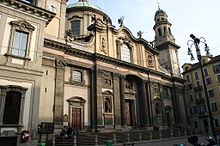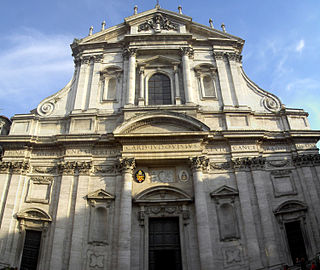
The Church of St. Ignatius of Loyola at Campus Martius is a Roman Catholic titular church, of deaconry rank, dedicated to Ignatius of Loyola, the founder of the Society of Jesus, located in Rome, Italy. Built in Baroque style between 1626 and 1650, the church functioned originally as the chapel of the adjacent Roman College, that moved in 1584 to a new larger building and was renamed the Pontifical Gregorian University.

The Barnabites, formally the Clerics Regular of Saint Paul, are a religious order of clerics regular of Pontifical Right founded in 1530 in the Catholic Church. They may use the postnominal initials of simply "B." or "C.R.S.P.". Associated to the members of the Order are the Angelic Sisters of St. Paul and the lay members of the Barnabite lay movement.
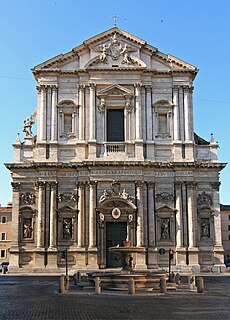
Sant'Andrea della Valle is a minor basilica in the rione of Sant'Eustachio of the city of Rome, Italy. The basilica is the general seat for the religious order of the Theatines. It is located at Piazza Vidoni, 6 at the intersection of Corso Vittorio Emanuele and Corso Rinascimento.
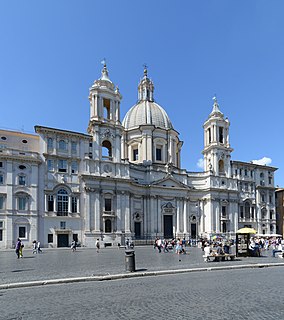
Sant'Agnese in Agone is a 17th-century Baroque church in Rome, Italy. It faces onto the Piazza Navona, one of the main urban spaces in the historic centre of the city and the site where the Early Christian Saint Agnes was martyred in the ancient Stadium of Domitian. Construction began in 1652 under the architects Girolamo Rainaldi and his son Carlo Rainaldi. After numerous quarrels, the other main architect involved was Francesco Borromini.
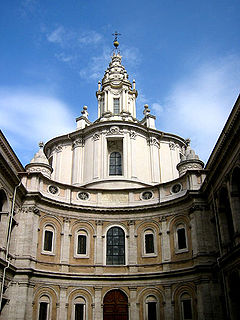
Sant'Ivo alla Sapienza is a Roman Catholic church in Rome. Built in 1642-1660 by the architect Francesco Borromini, the church is widely regarded a masterpiece of Roman Baroque architecture.

San Carlo ai Catinari, also called Santi Biagio e Carlo ai Catinari is an early-Baroque style church in Rome, Italy. It is located on Piazza Benedetto Cairoli, 117 just off the corner of Via Arenula and Via dei Falegnami, a few blocks south of the church of Sant'Andrea della Valle.

Santa Maria in Vallicella, also called Chiesa Nuova, is a church in Rome, Italy, which today faces onto the main thoroughfare of the Corso Vittorio Emanuele and the corner of Via della Chiesa Nuova. It is the principal church of the Oratorians, a religious congregation of secular priests, founded by St Philip Neri in 1561 at a time in the 16th century when the Counter Reformation saw the emergence of a number of new religious organisations such as the Society of Jesus (Jesuits), the Theatines and the Barnabites.
Lorenzo Binago (1554–1629) was an Italian late Mannerist/early Baroque architect in Milan. He was by vocation, also a Barnabite monk.

Santa Maria del Carmine is a church of the Carmelite Order, in the Oltrarno district of Florence, in Tuscany, Italy. It is famous as the location of the Brancacci Chapel housing outstanding Renaissance frescoes by Masaccio and Masolino da Panicale, later finished by Filippino Lippi.

Filippo Abbiati (1640–1715) was an Italian painter of the early-Baroque period, active in Lombardy and Turin, together with Andrea Lanzani and Stefano Maria Legnani, he was a prominent mannerist painters from the School of Lombardy. Born in Milan, he was a pupil of the painter Antonio Busca. Alessandro Magnasco was one of his pupils along with Pietro Maggi and Giuseppe Rivola. Ticozzi claims he trained, along with Federigo Bianchi, with Carlo Francesco Nuvolone. Along with Bianchi, he painted the cupola of Sant'Alessandro Martire in Milan. Abbiati also painted a St. John preaching in the Wilderness for a church in Saronno.

San Barnaba is a church in Milan, Italy. It is the first edifice of the Barnabites order.

Italian Baroque architecture refers to Baroque architecture in Italy.

The Church of Saint Anne in the Vatican, known as Sant'Anna de' Parafrenieri, is a Roman Catholic parish church dedicated to Saint Anne in Vatican City. The church is the parish church of the State of Vatican City and is placed under the jurisdiction of the Vicariate of the Vatican City and is located beside the Porta Sant'Anna, an international border crossing between Vatican City State and Italy.

Sant’Alessandro Maggiore is a Romanesque-style, Roman Catholic parish church in Lucca, region of Tuscany, Italy.
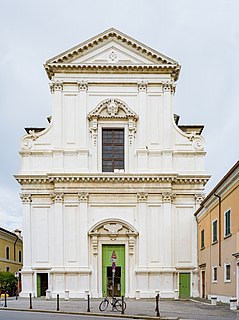
The church of Sant'Afra in Brescia, also known as the church of Sant'Afra in Sant'Eufemia, is located on Corso Magenta, near Piazzale Arnaldo.

The Church of Santa Maria di Caravaggio is a Baroque Catholic church located on Piazza Dante, in Naples, Italy.

San Dalmazzo is a Roman Catholic church on via Garibaldi, in central Turin, region of Piedmont, Italy. It is dedicated to Saint Dalmatius of Pavia.

Sant'Antonio Abate is a Baroque-style, Roman Catholic church located on Via Bella at Piazzetta don Galliano, in Acqui Terme, Province of Alessandria, region of Piedmont, Italy.

Ermenegildo Pini (1739–1825) was an Italian clergyman, naturalist, mathematician, geologist and philosopher. He belonged to the Barnabite Order and worked mainly in northern Italy. He attempted to examine scientific ideas on geological phenomena and fossils and show them as being consistent with the framework of Biblical Genesis.

The Basilica of the National Shrine of Our Lady of Fatima is a Modernist Minor basilica and US National Shrine of the Roman Catholic Church, honoring the Blessed Virgin Mary as Our Lady of Fatima, the Patroness of the United States. The shrine is directed by The Barnabite Fathers. It is located at 1023 Swann Road in Lewiston, New York, USA, north of Niagara Falls.
